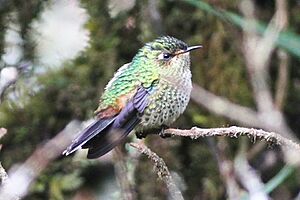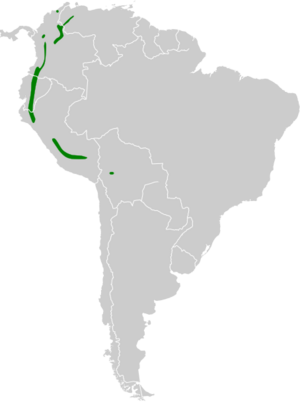Purple-backed thornbill facts for kids
Quick facts for kids Purple-backed thornbill |
|
|---|---|
 |
|
| Female in Puracé National Natural Park, Cauca, Colombia | |
| Conservation status | |
| Scientific classification | |
 |
|
| Distribution of Purple-backed thornbill |
The purple-backed thornbill (Ramphomicron microrhynchum) is a tiny, colorful hummingbird. You can find it in South American countries like Bolivia, Colombia, Ecuador, Peru, and Venezuela. It's known for having the shortest bill of all hummingbirds!
Contents
What Kind of Bird Is It?
The purple-backed thornbill is a type of hummingbird. It belongs to a group called "coquettes." It's very similar to another bird, the black-backed thornbill.
There are four slightly different kinds, or subspecies, of the purple-backed thornbill:
- R. m. andicola
- R. m. microrhynchum
- R. m. albiventre
- R. m. bolivianum
Some scientists think that R. m. andicola and R. m. albiventre are very much like the main kind, R. m. microrhynchum.
What Does It Look Like?
This little bird is about 8 to 9 centimeters (about 3 to 3.5 inches) long. It weighs around 3.5 grams (about 0.12 ounces). Both male and female birds have a very short, black beak.
Male Birds
Male purple-backed thornbills have shiny, metallic violet-purple feathers on their backs. They have a small white spot behind each eye. Their throat feathers, called a gorget, are a bright, iridescent golden green. Their belly is bronzy green, and the feathers under their tail are coppery with light brown edges. The tail is dark purple, forked, and medium length.
Female Birds
Female birds have shining green feathers on their backs. Like the males, they also have a white spot behind each eye. Their belly is white with green dots, except for the very middle part. The female's tail is shorter and less forked than the male's. It is bronzy purple, and the two outer feathers have white tips.
Different Subspecies
- The R. m. andicola males have a golden gorget with green edges. Their undertail feathers are more reddish-brown.
- The R. m. albiventre looks a lot like the main kind. Its male's undertail feathers have lighter edges. The female's belly has smaller green dots.
- The R. m. bolivianum males have metallic violet backs. Their bellies are dark green, and their undertail feathers are grayish white.
Where Do They Live?
The different kinds of purple-backed thornbills live in various parts of the Andes mountains:
- R. m. andicola lives in the Andes of western Venezuela, especially in Mérida state.
- R. m. microrhynchum lives in the Andes of Colombia, Ecuador, and Cajamarca in northwestern Peru.
- R. m. albiventre lives on the eastern slopes of the Andes in Peru. You can find it from Huánuco south to Apurímac and Cuzco.
- R. m. bolivianum lives in the Andes of Cochabamba Department in central Bolivia.
These birds like to live at the edges of humid mountain forests. They also live in Polylepis forests, páramo (a type of grassland), and areas where these habitats meet. The R. m. bolivianum can also be found in bushy areas below the treeline. They live at high elevations, from about 1,700 to 3,600 meters (about 5,600 to 11,800 feet) above sea level.
How Do They Behave?
Movement
The purple-backed thornbill moves from lower to higher places when it's the wet season.
Feeding
This hummingbird drinks nectar from flowers found from the middle of trees all the way up to the very top. It often visits flowers in a regular route, like a delivery person on a route. Sometimes, it "robs" nectar from holes that other birds, called Diglossa flowerpiercers, have made in flowers. It drinks nectar from many different kinds of plants, bushes, and trees. Besides nectar, it also eats insects. It catches insects while flying or picks them off flowers.
Reproduction
We don't know everything about when purple-backed thornbills breed. But it seems to be from May, possibly until December. They build a cup-shaped nest using fine plant fibers. They decorate the outside with moss and lichens. They place their nest on a horizontal tree branch. A female usually lays two eggs. The eggs hatch after about 16 days.
Vocalization
The purple-backed thornbill's song is a continuous series of quiet, scratchy notes. These notes are mixed with short buzzing sounds or dry trills. Its calls include a short, dry rattle like "trrr," a scratchy "krr-kit," and a long, twittering rattle.
What Is Their Status?
The IUCN (International Union for Conservation of Nature) says the purple-backed thornbill is a species of "Least Concern." This means it's not currently in danger of disappearing. It lives in a large area, but we don't know exactly how many there are. Scientists believe their numbers are going down. It's generally not a common bird where it lives. It can be found in some protected areas. However, outside these areas, its home is greatly threatened by deforestation, which is when forests are cut down.


